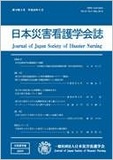Japanese
English
- 有料閲覧
- Abstract 文献概要
- 参考文献 Reference
- サイト内被引用 Cited by
要約
目的
東日本大震災後,A県B市に広域避難した高齢被災者が生活力量を形成していく過程を明らかにする。
方法
広域避難した高齢被災者3名に半構成的面接を行い,質的記述的に分析した。
結果
生活力量を形成していく過程を被災期,避難所生活期,広域避難生活期に分類した結果,生活力量を形成していく過程として【特異な喪失体験をする】【過酷な環境で生き抜く】【家族と伴に行動する】【新たに生活を再構築する】【社会的役割を見出す】の5のカテゴリーが抽出された。
結論
高齢被災者は,被災による特異的な喪失体験をし,被災後の生活に折り合いをつけ,生活力量を形成していた。被災後,生き抜くうえで,生命を脅かす危険がなく,衣食住の保証,他者と情緒的な繋がり,家族と行動を供にすることで安心感を形成していた。また,広域避難先で家族・被災者・地域住民らと親密な関係性の継続と社会的役割を見出すことで,現在の生活をコントロールしていた。
Objective: This study aimed to elucidate the process by which elderly victims who underwent wide-area evacuations in City B of Prefecture A regained their ability to control life after the Great East Japan Earthquake.
Method: we conducted a semi-structured interview with three elderly victims who underwent wide-area evacuation and performed a qualitative analysis of the obtained data.
Results: We classified the process of forming the ability to control life based on the disaster, shelter life, and wide-area evacuation life period.
Regarding for the process of forming vital capabilities, we extracted five categories as follows: “Experiencing a unique loss experience,” “Surviving in a harsh environment,” “Acting with family members,” “Building a new life,” and “Finding a social role.”
Conclusion: Elderly victims experienced a unique loss because of the disaster, attaining a balance after the disaster, and developed the ability to control life.
After the disaster, there was no danger to life, there was guarantee of food, clothing, shelter and emotional connection with other people were guaranteed. With their family and actions, they formed a sense of security.
Furthermore they have controlled their current lives by continuing close relationships with families, the victims, local residents, and performing social roles in the area.
Copyright © 2018, Japan Society of Disaster Nursing All rights reserved.


